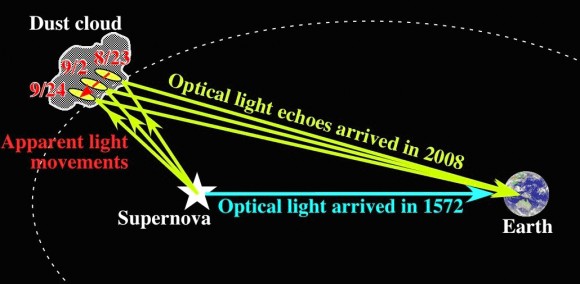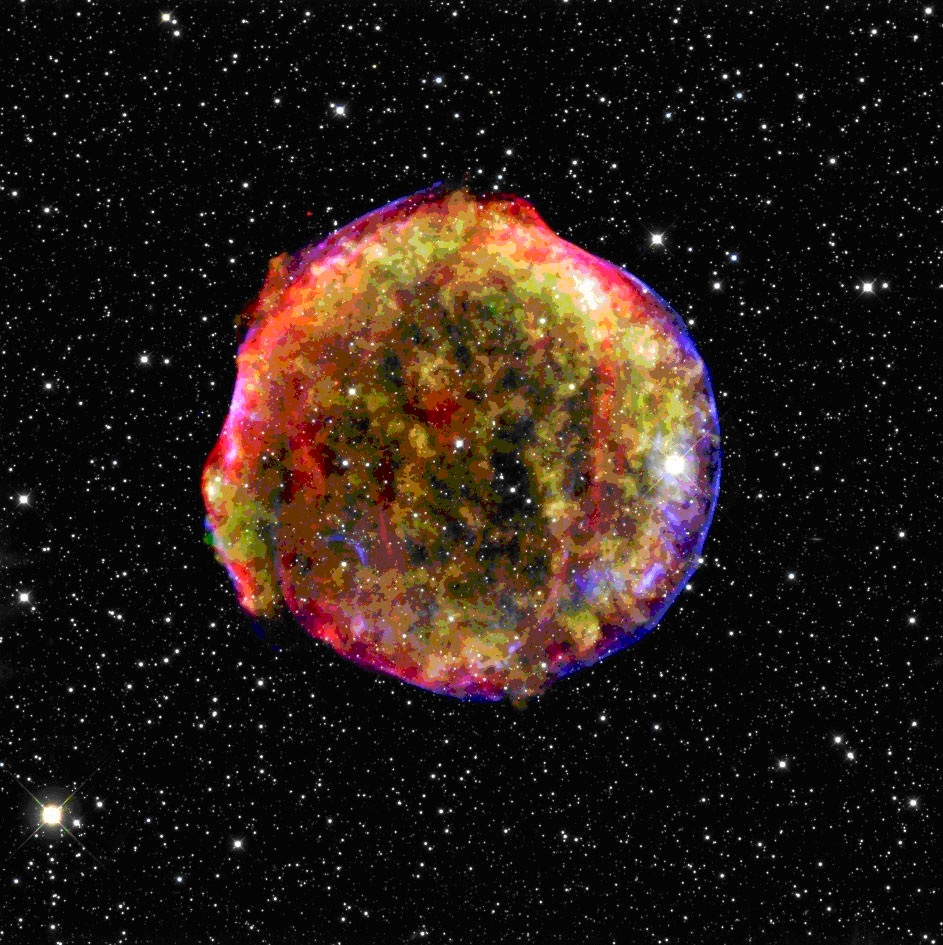[/caption]
On November 11, 1572 Danish astronomer Tycho Brahe and other skywatchers observed what they thought was a new star. A bright object appeared in the constellation Cassiopeia, outshining even Venus, and it stayed there for several months until it faded from view. What Brahe actually saw was a supernova, a rare event where the violent death of a star sends out an extremely bright outburst of light and energy. The remains of this event can still be seen today as Tycho’s supernova remnant. Recently, a group of astronomers used the Subaru Telescope to attempt a type of time travel by observing the same light that Brahe saw back in the 16th century. They looked at ‘light echoes’ from the event in an effort to learn more about the ancient supernova.
A ‘light echo’ is light from the original supernova event that bounces off dust particles in surrounding interstellar clouds and reaches Earth many years after the direct light passes by; in this case, 436 years ago. This same team used similar methods to uncover the origin of supernova remnant Cassiopeia A in 2007. Lead project astronomer at Subaru, Dr. Tomonori Usuda, said “using light echoes in supernova remnants is time-traveling in a way, in that it allows us to go back hundreds of years to observe the first light from a supernova event. We got to relive a significant historical moment and see it as famed astronomer Tycho Brahe did hundreds of years ago. More importantly, we get to see how a supernova in our own galaxy behaves from its origin.”

On September 24, 2008, using the Faint Object Camera and Spectrograph (FOCAS) instrument at Subaru, astronomers looked at the signatures of the light echoes to see the spectra that were present when Supernova 1572 exploded. They were able to obtain information about the nature of the original blast, and determine its origin and exact type, and relate that information to what we see from its remnant today. They also studied the explosion mechanism.
What they discovered is that Supernova 1572 was very typical of a Type Ia supernova. In comparing this supernova with other Type Ia supernovae outside our galaxy, they were able to show that Tycho’s supernova belongs to the majority class of Normal Type Ia, and, therefore, is now the first confirmed and precisely classified supernova in our galaxy.
This finding is significant because Type Ia supernovae are the primary source of heavy elements in the Universe, and play an important role as cosmological distance indicators, serving as ‘standard candles’ because the level of the luminosity is always the same for this type of supernova.
For Type Ia supernovae, a white dwarf star in a close binary system is the typical source, and as the gas of the companion star accumulates onto the white dwarf, the white dwarf is progressively compressed, and eventually sets off a runaway nuclear reaction inside that eventually leads to a cataclysmic supernova outburst. However, as Type Ia supernovae with luminosity brighter/fainter than standard ones have been reported recently, the understanding of the supernova outburst mechanism has come under debate. In order to explain the diversity of the Type Ia supernovae, the Subaru team studied the outburst mechanisms in detail.
This observational study at Subaru established how light echoes can be used in a spectroscopic manner to study supernovae outburst that occurred hundreds of years ago. The light echoes, when observed at different position angles from the source, enabled the team to look at the supernova in a three dimensional view. This study indicated Tycho’s supernova was an aspherical/nonsymmetrical explostion. For the future, this 3D aspect will accelerate the study of the outburst mechanism of supernova based on their spatial structure, which, to date, has been impossible with distant supernovae in galaxies outside the Milky Way.
The results of this study appear in the 4 December 2008 issue of the science journal Nature.
Source: Subaru Telescope


Okay this isn’t a very scientific observation but I’ll state it anyway. The image of this supernova is beautiful and it displays the magnificence of our universe.
This is absolutely amazing and fabulous! I am surprised it does not get much more boost in the media. I always dreamed about the possibility of peeking into the past through cosmic mirrors, but had no idea it is already technologically possible. Although it is still far from watching the Earth hundreds or millions years ago, it is absolutely fascinating anyway! Or perhaps even more important than that.
whe have named a observatory after tycho brahe. a great dane :p
we have named a observatory after tycho brahe. in copenhagen. a great dane
Wait. Can someone please explain:
1) How the astronomers knew WHERE to look.
2) How the astronomers knew WHEN to look.
Are they simply scanning the nearby space for dust clouds that might reflect the supernova back to Earth? If so, that’s pretty “needle in a hay stack (or more like hay mountain)” no?
Ah, but consider that the light from Earth from millions to hundreds of millions of years ago, is only now reaching viewing spots millions to hundreds of millions of light years away. Imagin a telescope orbiting some star 50 million light years away, peering down onto Earth. Aim a telescope from Earth orbit, like Hubble, directly into the viewer of the telescope 50 million ligh ears away, and you will be seeing Earth as it was then. Let’s do the same thing from say, 10 light minutes away and sell it as a carnival attraction – See Yourself Contemplate Paying the $5, 10 Minutes Ago!!!
Yeah, you can do the same thing with a camera.
I think they would have calculated where the light would reflect from in order to reach here now – i.e., where is a mirror to this event about 436 light years away from the event, and then scour that neighborhood.
2 Bonr: since the distances to both the supernova and the dust clod are known, as well as the time of the supernova explosion, it is mathematically not that difficult to pick up the right target to watch (if there is one available). Of course it is not trivial, but it is definitely not a needle in a hay stack
I wonder if this can be done on a larger scale – looking at reflections from distant galaxies of the earier universe.
I would imagine that there is a lot of noise and degradation, though.
Another thing…
When the white dwarf explodes, what happens to the companion star? Does it survive, and how is if affected by the blast?
Something doesn’t quite add up. This article implies, to me at least, that the top image is the reflected light from the 1572 event. I will wager that it is in fact an image of the remnant as it appears from Earth today.
Isn’t there a rule that all images should be credited and captioned and explained in the text? Has anyone else noticed the abuses that occur in pop sci magazines like new scientist. my pet peeve i guess.
The achievement is stellar! Bravo!
Procyan- All the images have captions and credits, but sometimes they don’t show up correctly in our publishing software. So if you don’t see a caption, put your mouse over the image and the caption will show up. Its frustrating for us writers when the captions don’t show up, because we take the effort to put them all in!
The top image is a combination of data from Spitzer, Chandra and a ground based telescope at Calar Alto.
Nancy
Could there be some way to look at light reflected from Earth (and back) to look back in time at our own planet?
I realize that only a small quantity of light would behave in this manner so the light would be very faint and the data sparse. But I think this proves that it’s at least theoretically feasible.
Very unlikely Nic. By the time any photons bounced off the Earth (from the Sun) were reflected off a nebula there would be so few of them that you would not be able to distinguish them from light from the Sun and other sources anyway.
Remember, supernovae, at the moment of ignition, are just about the brightest objects in the universe, so they produce a untold numbers of photos ready to bounce off anything that gets in the way. Even then the echos are very faint. Light from planets or even ordinary stars won’t cut it.